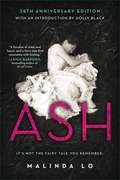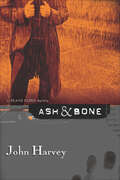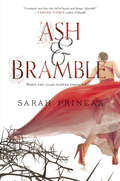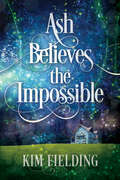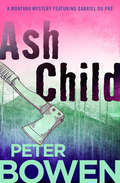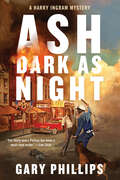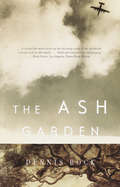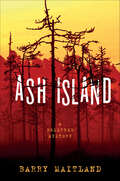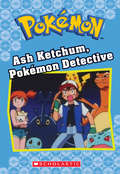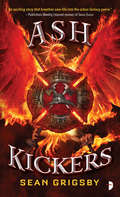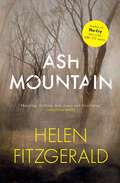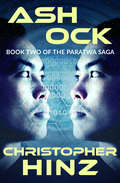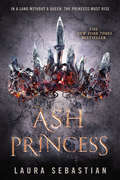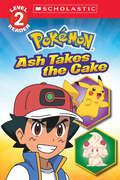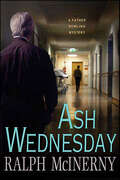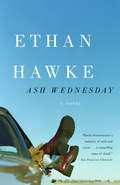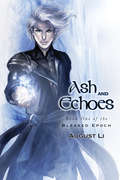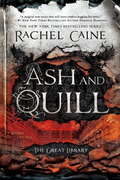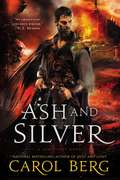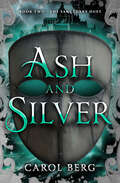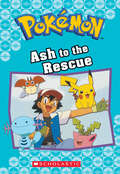- Table View
- List View
Ash
by Malinda LoIn the wake of her father's death, Ash is left at the mercy of her cruel stepmother. Consumed with grief, her only joy comes by the light of the dying hearth fire, rereading the fairy tales her mother once told her. In her dreams, someday the fairies will steal her away, as they are said to do. When she meets the dark and dangerous fairy Sidhean, she believes that her wish may be granted. The day that Ash meets Kaisa, the King's Huntress, her heart begins to change. Instead of chasing fairies, Ash learns to hunt with Kaisa. Though their friendship is as delicate as a new bloom, it reawakens Ash's capacity for love-and her desire to live. But Sidhean has already claimed Ash for his own, and she must make a choice between fairy tale dreams and true love. Entrancing, empowering, and romantic, Ash is about the connection between life and love, and solitude and death, where transformation can come from even the deepest grief..
Ash
by Malinda LoIn the world of ASH, fairies are an older race of people who walk the line between life and death, reality and magic. As orphaned Ash grows up, a servant in her stepmother's home, she begans to realise that her beloved mother, Elinor, was very much in tune with these underworld folk, and that she herself has the power to see them too. Against the sheer misery of her stepmother's cruelty, greed and ambition in preparing her two charmless daughters for presentation at court, and hopefully royal or aristocratic marriage, Ash befriends one of these fairies - a mysterious, handsome man - who grants her wishes and restores hope to Ash's existence, even though she knows there will be a price to pay. But most important of all, she also meets Kaisa, a huntress employed by the king, and it is Kaisa who truly awakens Ash's desires for both love and self-respect ...ASH is a fairy tale about possibility and recognizing the opportunities for change. From the deepest grief comes the chance for transformation.
Ash & Bone: A Frank Elder Mystery (Frank Elder Mysteries) (The Frank Elder Mysteries #2)
by John HarveyIn this follow-up to the Silver Dagger Award–winning Flesh & Bone, a retired detective is drawn into the case of a murdered former cop.In the depths of his Cornish hideaway, retired Detective Inspector Frank Elder’s solitary life is disturbed by a call from his ex-wife, telling him his seventeen-year-old daughter, Katherine, is running wild, unbalanced by the abduction and rape he feels he should have prevented. Meanwhile, in the heart of London, the takedown of a violent criminal goes badly, and Detective Sergeant Maddy Birch is uneasy about the reasons why—an uneasiness that is compounded when she starts to believe she is being stalked. Maddy and Frank had a brief and clumsy encounter years before. In Ash & Bone their lives connect again when a second phone call persuades Elder out of retirement, only to find that a cold case has a devastating present-day impact.
Ash & Bramble
by Sarah PrineasThe tale of Cinderella has been retold countless times. But what you know is not the true story. Sarah Prineas's bold fairy-tale retelling is a dark and captivating world where swords are more fitting than slippers, young shoemakers are just as striking as princes, and a heroine is more than ready to rescue herself before the clock strikes midnight.Pin has no recollection of who she is or how she got to the Godmother's fortress. She only knows that she is a Seamstress, working day in and out to make ball gowns fit for fairy tales. But she longs to forsake her backbreaking servitude and dares to escape with the brave young Shoemaker.Pin isn't free for long before she's captured again and forced to live the new life the Godmother chooses for her--a fairy-tale story, complete with a charming prince--instead of finding her own happily ever after.When the glass slipper just doesn't fit . . .
Ash Believes the Impossible
by Kim FieldingAsher Kaufman could use a miracle. But first he&’ll have to believe they exist.Ash is single, strapped for cash, and burned out from his work at a nonprofit. Everyone else&’s holiday spirit leaves him feeling like he&’s in the wrong movie.Then strange, thoughtful gifts begin appearing outside his door: a rustic basket filled with pinecones and acorns, and a beautiful handmade scarf in Hannukah colors. But the most wonderful gift of all comes when he meets Clay, his secret admirer, a beautiful young man who happens to be a fairy who lives in the wooded wonderland behind the duplex where Ash lives.Clay brings warmth and magic into Ash&’s dreary life–but when the realities of the human world threaten the bridge to fairyland, it will take all Ash&’s faith to bring about a happy-ever-after that will work for everyone.
Ash Child (The Montana Mysteries Featuring Gabriel Du Pré #9)
by Peter BowenIn modern-day Montana, brushfires, meth dealers, and murder challenge a deputy in a mystery that&’s &“a pleasure to read&” (Publishers Weekly). In the midst of a drought in Toussaint, Montana, Métis Indian tracker and cattle investigator Gabriel Du Pré learns that Maddy Collins has been killed—and goes looking for answers. Du Pré suspects a pair of boys who, despite their good upbringing, have fallen in with a gang of crystal meth dealers. Not long after the murder, they vanish. As the town is threatened by a forest fire, Du Pré puts his own life at risk to hunt for the two young men, not knowing whether they&’re alive or dead. But if the inferno reaches Toussaint, no one will be safe.Ash Child is the 9th book in The Montana Mysteries Featuring Gabriel Du Pré series, but you may enjoy reading the series in any order.
Ash Dark as Night (A Harry Ingram Mystery #2)
by Gary PhillipsIn the follow-up to One-Shot Harry, fearless crime photographer and occasional private eye Harry Ingram finds himself in the LAPD's crosshairs after capturing damning evidence of police brutality. An atmospheric dive into a city on the brink that's brimming with remarkable historical detail, Ash Dark as Night is perfect for fans of Walter Mosley and James Ellroy.Los Angeles, August 1965. Anger and pent-up frustrations boil over in the Watts neighborhood after a traffic stop of two Black motorists. As the Watts riots explode, crime photographer Harry Ingram snaps photos at the scene, including images of the police as they unleash batons, dogs, and water hoses on civilians. When he captures the image of an unarmed activist being shot down by the cops, he winds up in the hospital, beaten, his camera missing. Proof of the unjust killing seems lost—until Ingram&’s girlfriend, Anita Claire, retrieves the hidden film in a daring rescue. The photo makes front-page news.A recuperating Ingram is approached by Betty Payton, a comrade of Anita&’s mother, who wants Ingram&’s help tracking down her business associate Moses &“Mose&” Tolbert, last seen during the riots. Ingram follows the investigation down a rabbit hole of burglary rings, bank robberies, looted cash, and clandestine agendas—all the while grappling with his newfound fame, which puts him in the sightlines of LAPD&’s secretive intelligence division.Ash Dark as Night is a nail-biting ride-along through midcentury Los Angeles with a crime fiction legend in the driver&’s seat.
Ash Garden
by Dennis BockWHAT WOULD HAPPEN IF A HIROSHIMA SURVIVOR ENCOUNTERED ONE OF THE SCIENTISTS RESPONSIBLE FOR THE ATOMIC BOMB? This is the way Emiko Amai recalls August 6th, 1945 - the day she survived the Hiroshima bomb. Emiko was six years old, her parents killed, her younger brother hanging on to life by a thread. A decade later Emiko was among the twenty-five 'Hiroshima maidens' brought for reconstructive surgery to the United States. For Anton Böll and his colleagues at Los Alamos, New Mexico, news of the explosion was confirmation of a dream. Böll was a refugee of conscience from Germany, a recruit to Oppenheimer's Manhattan Project who believed the sooner they cracked these nuclear equations, the safer the world would be. With remarkable clarity and perception Dennis Bock's compelling and poignant novel explores what happens half a century later, when Anton and Emiko finally stand face-to-face.
Ash Island: A Belltree Mystery (The Belltree Trilogy #2)
by Barry Maitland“One of the best books of 2015!” —Kirkus Reviews on Crucifixion CreekDetective Sergeant Harry Belltree is back on the job after a near-fatal confrontation with corrupt colleagues and his presence has become a departmental embarrassment. Because of what happened, he can’t—and doesn’t want to—return to his old position with the Sydney Police Department. Instead, he accepts a post with a police department far away and attempts to build a new, quiet life in Newcastle, Australia. But that quiet life soon eludes him. A corpse has been found buried just offshore on Ash Island and that one body may well just be the first of many. Not only that, Belltree finds himself engaged in some unfinished business from his own past. The car crash that killed his parents and blinded his wife happened not far from Newcastle. Belltree knows it was no accident, but his own investigations lead him to wonder how well he really knew his own parents. With his wife Jenny now pregnant, a much longed-for event, it’s up to Belltree to decide how he can confront the evil from the past while protecting his loved ones in the present and future.
Ash Ketchum, Pokémon Detective (Pokémon Chapter Books)
by Tracey WestCatch this action-packed adventure about Ash, Pikachu, and their friends! This chapter book features classic characters featured on Netflix and in Pokémon Go.Is a Pokémon lost, missing, or acting strange? Ash Ketchum, Pokémon P.I., is on the case. With the help of his friends and trusty sidekick, Pikachu, Ash must solve mysteries involving spooky Pokémon like Hoothoot, Spinarak, and Stantler. This chapter book is based on a thrilling storyline from the top-rated animated series now on Netflix. Black-and-white illustrations throughout.
Ash Kickers (Smoke Eaters #2)
by Sean GrigsbyDragons vs Firefighters vs the Phoenix. The scorching fantasy sequel to Smoke Eaters.With ex-firefighter Cole Brannigan in command of the Smoke Eaters, the dragon menace is under control. Thanks to non-lethal Canadian tech, the beasts are tranquilized and locked up, rather than killed. But for Tamerica Williams, this job filled with action and danger, has become tediously routine. When a new threat emerges, a legendary bird of fire – the Phoenix – it’s the perfect task for Williams. But killing the Phoenix just brings it back stronger, spreading fire like a plague and whipping dragons into a frenzy. Will it prove to be too much excitement, even for adrenalin-junkie Williams? File Under: Fantasy [ Smoke Em | Catch and Release | Fire Bird | Arson About ]
Ash Mountain
by Helen FitzGeraldFran thought she&’d never return to Ash Mountain but her dad has become ill, her relationship is over, and she hates her dead-end job in the city anyway. In a blistering summer, childhood memories prick at her fragile self-esteem as old friendships and rivalries are renewed and new ones forged. But the tumult of her home life is the least of her worries, because a bushfire is roaring towards Ash Mountain and the town&’s long-held secrets will soon be exposed in the carnage.
Ash Ock (Paratwa #2)
by Christopher HinzA quarter of a millennium ago, before the nuclear apocalypse forced the inhabitants of earth to flee their home planet, few humans could have imagined the course their path would take. Now, the orbital colonies are the final sanctuary of humanity and life is more dangerous than ever before. The colonists fear the return of their dreaded enemies, the Paratwa--ferocious warriors who are genetically engineered to exist in two bodies which remain telepathically connected. The new generation of Paratwa is far deadlier than the old, forming a powerful caste of fighter known as the Ash Ock. A mysterious virus infecting the humans database signals the return of their most feared enemies...
Ash Ock: The Paratwa Saga, Book II (Paratwa Ser. #2)
by Christopher HinzA compelling novel of humanity fighting back against telepathically linked killers in a postapocalyptic world…A quarter of a millennium ago, before the nuclear apocalypse forced the inhabitants of earth to flee their home planet, few humans could have imagined the course their path would take. Now, the orbital colonies are the final sanctuary of humanity and life is more dangerous than ever before. The colonists fear the return of their dreaded enemies, the Paratwa – ferocious warriors who are genetically engineered to exist in two bodies which remain telepathically connected. The new generation of Paratwa is far deadlier than the old, forming a powerful caste of fighter known as the Ash Ock. A mysterious virus infecting the humans database signals the return of their most feared enemies…
Ash Princess (Ash Princess #1)
by Laura SebastianFor fans of Victoria Aveyard's Red Queen and Sabaa Tahir's An Ember in the Ashes, Ash Princess is an epic new fantasy about a throne cruelly stolen and a girl who must fight to take it back for her people. <P><P>Theodosia was six when her country was invaded and her mother, the Fire Queen, was murdered before her eyes. On that day, the Kaiser took Theodosia's family, her land, and her name. Theo was crowned Ash Princess--a title of shame to bear in her new life as a prisoner. <P>For ten years Theo has been a captive in her own palace. She's endured the relentless abuse and ridicule of the Kaiser and his court. She is powerless, surviving in her new world only by burying the girl she was deep inside. <P>Then, one night, the Kaiser forces her to do the unthinkable. With blood on her hands and all hope of reclaiming her throne lost, she realizes that surviving is no longer enough. But she does have a weapon: her mind is sharper than any sword. And power isn't always won on the battlefield. <P>For ten years, the Ash Princess has seen her land pillaged and her people enslaved. That all ends here. <P><b>A New York Times Bestseller</b>
Ash Road
by Ivan SouthallA raging fire spreading in the Australian bush cuts off the escape of the children and two old men entrusted to their care.
Ash Takes the Cake (Scholastic Reader, Level 2)
by Maria S. BarboKids can practice their reading skills with Pokémon in this fun Level 2 Reader.Join Ash and Pikachu on a sweet adventure in this Level 2 Reader! This easy-to-read book features a cake decorating contest where Trainers partners with Alcremie, the Cream Pokémon—and a battle where Pikachu eats more cream than it can handle!With full-color illustrations on every page, this exciting but simple story is based on an episode from the hit animated TV series.
Ash Wednesday (Father Dowling Mysteries)
by Ralph McInernyWith parishioners up in arms, Father Dowling has to prove beyond a shadow of a doubt that a conviction is no proof of guilt in Ash Wednesday, the newest addition to Ralph McInerny's acclaimed and beloved mystery series.Father Dowling has been serving as parish priest and resident sleuth at St. Hilary's for a while now, but he's no lifer, and there's plenty that he doesn't know about the old guard. So when a stranger comes to Fox River who isn't a stranger to anyone but him, he has to rely on his prying housekeeper to tell him that the mystery man is actually a well-known murderer. Ten years ago, Nathaniel Green's wife was dying of cancer, and after a short remission she relapsed into a coma. That small sliver of hope so utterly dashed must have been too much for him because when the nurses came to check on her they found that he had taken her off of her life support. Green's return divides the community, but the more Father Dowling ponders the moral questions and reinvestigates the case, the more he wonders if Green committed any crime at all.
Ash Wednesday (Vintage Contemporaries Ser.)
by Ethan HawkeTWO PEOPLE, THREE LIVES, ONE LOVE Is there anything more terrifying than being in love? Jimmy Heartsock is so afraid of losing his love Christy, he is going AWOL from the army and chasing after her in order to propose marriage - in a frozen car park. Christy is terrified, not so much that she's going to have a baby, but because if she takes on Jimmy Heartsock, she may end up with two. How does anyone, ever, make it down the aisle? Can Jimmy stop looking vainly into mirrors, taking recreational drugs, or blaming his father for committing suicide - will he ever grow up? Can Christy stop feeling that their destiny together is to break each others hearts, that there is a glass wall between her and the world and that her Texan politician father could avert any calamity - if only she deserved it? Are they a couple so afraid of falling, it would be easier to jump? Will they, won't they mess this thing up? As the unforgettable lovers drive across America, confronting family history, personal hang-ups and questions they've never even asked each other before - about faith, death and learning how to live - the reader is caught up in a sensationally moving, funny and nail-biting drama of love in our time
Ash and Echoes (Blessed Epoch #1)
by August Li Augusta Li2nd EditionBook One of the Blessed EpochFor the past few years Yarroway L'Estrella has lived in exile, gathering arcane power. But that power came at a price, and he carries the scars to prove it. Now he must do his duty: his uncle, the king, needs him to escort Prince Garith to his wedding, a union that will create an alliance between the two strongest countries in the known world. But Yarrow isn't the prince's only guard. A whole company of knights is assigned to the mission, and Yarrow's not sure he trusts their leader. Knight Duncan Purefroy isn't sure he trusts Yarrow either, but after a bizarre occurrence during their travels, they have no choice but to work together--especially since the incident also reveals a disturbing secret, one that might threaten the entire kingdom. The precarious alliance is strained further when a third member joins the cause for reasons of his own--reasons that may not be in the best interests of the prince or the kingdom. With enemies at every turn, no one left to trust, and the dark power within Yarrow pulling dangerously away from his control, the fragile bond the three of them have built may be all that stands between them and destruction.First Edition published by Dreamspinner Press, June 2012.
Ash and Quill
by Rachel CaineThe unforgettable characters from Ink and Bone and Paper and Fire unite to save the Great Library of Alexandria from itself in this electrifying adventure in the New York Times bestselling series. Hoarding all the knowledge of the world, the Great Library jealously guards its secrets. But now a group of rebels poses a dangerous threat to its tyranny.... Jess Brightwell and his band of exiles have fled London, only to find themselves imprisoned in Philadelphia, a city led by those who would rather burn books than submit. But Jess and his friends have a bargaining chip: the knowledge to build a machine that will break the Library’s rule. Their time is running out. To survive, they’ll have to choose to live or die as one, to take the fight to their enemies—and to save the very soul of the Great Library....
Ash and Silver
by Carol BergIn Dust and Light, national bestselling author Carol Berg returned to the world of the award-winning Flesh and Spirit. Now she continues the saga of a man whose past is veiled in shadows.... Ever since the Order of the Equites Cineré stole his memory, his name, and his heart, thinking about the past makes Greenshank's head ache. After two years of rigorous training, he is almost ready to embrace the mission of the Order--to use selfless magic to heal the troubles of Navronne. But on his first assignment alone, the past comes racing back, threatening to drown him in conspiracy, grief, and murder. He is Lucian de Remeni--a sorcerer whose magical bents for portraiture and history threaten the safety of the earth and the future of the war-riven kingdom of Navronne. He just can't remember how or why. Fighting to unravel the mysteries of his power, Lucian must trace threads of corruption that reach from the Pureblood Registry into the Order itself, the truth hidden two centuries in the past and beyond the boundaries of the world... From the Trade Paperback edition.
Ash and Silver (The Sanctuary Duet)
by Carol BergIn this epic fantasy sequel to Dust and Light, a man without a past must restore his memory to save his kingdom. As a candidate for knighthood in the Order of the Equites Cineré, Greenshank had to give up his memory. It also means thinking of the past makes his head ache, but that hasn&’t stopped him from putting in two years of rigorous training. He is almost ready to embrace the order&’s mission—to use selfless magic to heal the fractured kingdom of Navronne. Still, trouble arises on his first solo assignment when he encounters a mysterious woman who brings his past rushing back . . . Greenshank discovers he was once a sorcerer with a different name. One whose gifts threaten the safety of the kingdom and the world. Now to unravel the mysteries of his past and his powers, he must trace a path of corruption that leads into some unexpected—and dangerous—places . . . &“Berg has an artist&’s touch with fantasy worlds and scenes.&” —RT Book Reviews &“With this masterful opening . . . the story grabs you by the hand, plunging you headfirst into a world of magic and war, where nothing is quite what it seems.&” —San Francisco Book Review &“I particularly enjoyed the structure and logic of the story, but it is the character Greenshanks that kept me reading. I wanted to go on the journey with him to recapture his lost memories and to see why he was so important to his world. The emotional nexus around him was compelling and the world he inhabited was one I could live in.&” —King&’s River Life Magazine
Ash from Coal and Biomass Combustion
by Bodhisatwa Hazra Pradeep K. Singh Ashok K. Singh Reginald Ebhin Masto Joan EsterleThis is a concise book with comprehensive information on coal and biomass ash generated from their combustion in thermal power plants. It presents detailed studies on ash generated from contrasting coal and biomass feedstocks, and provides a comparative evaluation of these different ashes in terms of their origin, properties, environmental hazards. Potential utilizations with specific advantages and disadvantages of the respective ashes are elaborated in detail, including some innovative means of ash utilization for value addition purposes. By addressing both the theory and commercial exploitation of these products, this book will be helpful for industrialists, academicians and researchers alike.
Ash to the Rescue (Pokémon Chapter Books)
by Tracey WestCatch this action-packed adventure about Ash, Pikachu, and their friends! This chapter book features classic characters featured on Netflix and in Pokémon Go!.Team Rocket is rounding up Pokémon in the Johto region! They can't wait to get their greedy hands on Ledyba, Hoppip, and Wooper. It's up to Ash to protect these Pokémon -- or so he thinks. These Pokémon have a plan of their own.... This chapter book is based on a thrilling storyline from the top-rated animated series now on Netflix. Black-and-white illustrations throughout.
